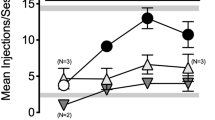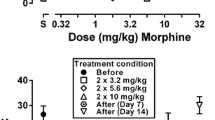Abstract
The effects of CCAM, an insurmountable mu opioid receptor antagonist, were studied on the intravenous self-administration and thermoantinociception of alfentanil and nalbuphine, high- and low-efficacy opioid agonists, respectively, in rhesus monkeys. A single dose of 0.1 mg/kg CCAM IV reduced alfentanil’s reinforcing potency in an FR30 TO 45s schedule 10-fold within a 24-h period. The maximum response rates remained essentially unchanged. At 1 mg/kg, CCAM caused a 300-fold shift of the alfentanil dose-response curve and also depressed the maximum response rates. CCAM also blocked insurmountably responding for nalbuphine, which was essentially abolished in two of three animals after a dose of 0.1 mg/kg CCAM and in all animals after 1 mg/kg. The acute insurmountable antagonism of alfentanil and nalbuphine self-administration by CCAM was used to determine the (relative initial) efficacy values of both agonists. Efficacy values, tau, were 391 for alfentanil and 196 for nalbuphine; the apparent in vivo dissociation constants, KA, were 0.16 mg/kg per injection (i.e., 350 nmol/kg per injection) for alfentanil and 0.14 mg/kg (370 nmol/kg per injection) for nalbuphine. In comparison, in a rhesus monkey 50°C warm-water tail withdrawal assay, the tau values were 11 for alfentanil and 0.92 for nalbuphine, and the KA values were 0.2 mg/kg (440 nmol/kg) for alfentanil and 0.15 mg/kg (400 nmol/kg) for nalbuphine. Therefore, it seems that the higher potency of alfentanil and nalbuphine in self-administration as compared to thermal antinociception in rhesus monkeys is predominantly due to a larger efficacy of the same agonist in self-administration (i.e., a larger receptor pool) rather than differences in apparent in vivo affinity.
Similar content being viewed by others
References
Adams RU, Paronis CA, Holtzman SG (1990) Assessment of relative intrinsic activity of mu-opioid analgesics in vivo by using beta-funaltrexamine. J Pharmacol Exp Ther 255: 1027–1032
Bertalmio AJ, Woods JH (1989) Reinforcing effect of alfentanil is mediated by mu opioid receptors: apparent pA2 analysis. J Pharmacol Exp Ther 251: 455–460
Black JW, Leff P (1983) Operational models of pharmacological agonism. Proc R Soc Lond B 220: 141–162
Black JW, Leff P, Shankley NP, Wood J (1985) An operational model of pharmacological antagonism: The effect of E/[A] curve shape on agonist dissociation constant estimation. Br J Pharmacol 84: 561–571
Bozarth MA (1987) Methods of assessing the reinforcing properties of abused drugs. Springer, New York
Burke TF, Woods JH, Lewis JW, Medzihradsky F (1994) Irreversible opioid antagonist effects of clocinnamox on opioid analgesia and mu receptor binding in mice. J Pharmacol Exp Ther 271:715–721
Comer SD, Burke TF, Lewis JW, Woods JH (1992) Clocinnamox: a novel, systemically-active irreversible opioid antagonist. J Pharmacol Exp Ther 262: 1051–1056
Deneau G, Yanagita T, Seevers MH (1969) Self-administration of psychoactive substances by the monkey. A measure of psychological dependence. Psychopharmacologia 16: 30–48
DiChiara G, North RA (1992) Neurobiology of opiate abuse. Trends Pharmacol Sci 13: 185–193
Duggan AW, North RA (1984) Electrophysiology of opioids. Pharmacol Rev 35: 219–281
Dykstra LA, Woods JH (1986) A tail withdrawal procedure for assessing analgesic activity in rhesus monkeys. J Pharmacol Meth 15: 263–269
Fibiger HC, Phillips AG (1988) Mesocorticolimbic dopamine systems and reward. Ann NY Acad Sci 57: 206–215
Furchgott RF (1966) The use of β-haloalkylamines in the differentiation of receptors and in the determination of dissociation constants of receptor-agonist complexes. Adv Drug Res 3: 21–56
Goldstein A (1989) Molecular and cellular aspects of the drug addiction. Springer, New York
Holzer P (1991) Capsaicin: cellular targets, mechanisms of action, and selectivity for thin sensory neurons. Pharmacol Rev 43: 143–201
Koob GF (1992) Drugs of abuse: anatomy, pharmacology and function of reward pathways. Trends Pharmacol Sci 13: 177–184
Nieuwenhuys R, Voogd J, vanHuijzen C (1978) The human central nervous system. Springer, New York
Portoghese PS, Larson DL, Sayre LM, Fries DS, Takemori AE (1980) A novel opioid receptor site directed alkylating agent with irreversible narcotic antagonistic and reversible agonistic activities. J Med Chem 23: 233–234
Stolerman I (1992) Drugs of abuse: behavioural principles, methods and terms. Trends Pharmacol Sci 13: 170–176
Takemori AE, Larson DL, Portoghese PS (1981) The irreversible narcotic antagonistic and reversible agonistic properties of the fumarate methyl ester derivative of naltrexone. Eur J Pharmacol 70: 445–451
Walker EA, Zernig G, Woods JH (1995) Buprenorphine antagonism of mu opioids in the rhesus monkey tail-withdrawal procedure. J Pharmacol Exp Ther 273: 1345–1352
Winger G, Palmer RK, Woods JH (1989) Drug-reinforced responding: rapid determination of dose-response functions. Drug Alcohol Depend 24: 135–142
Winger G, Skjoldager P, Woods JH (1992) Effects of buprenorphine and other opioid agonists and antagonists on alfentanil- and cocaine-reinforced responding in rhesus monkeys. J Pharmacol Exp Ther 261: 311–317
Winger G, Woods JH, Hursh SR (1996) Behavior maintained by alfentanil or nalbuphine in rhesus monkeys: fixed-ratio and time-out changes to establish demand curves and relative reinforcing effectiveness. Exp Clin Psychopharmacol 4: 131–141
Woods JH, Winger G, France CP (1992) Use of in vivo apparent pA2 analysis in assessment of opioid abuse liability. Trends Pharmacol Sci 13: 282–286
Young AM, Swain HH, Woods JH (1981) Comparison of opiod agonists in maintaining responding and in suppressing morphine withdrawal in rhesus monkeys. Psychopharmacology 74: 329–335
Zernig G, Butelman ER, Lewis JW, Walker EA, Woods JH (1994) In vivo determination of mu opiod receptor turnover in rhesus monkeys after irreversible blockade with clocinnamox. J Pharmacol Exp Ther 269: 57–65
Zernig G, Broadbear JH, Lewis JW, Brine GA, Woods JH (1995a) Opioid agonist effects on mouse writhing after irreversible mu receptor blockade with clocinnamox. Exp Clin Psychopharmacol 3: 323–329
Zernig G, Issaevitch T, Broadbear J, Burke T, Lewis JW, Brine GA, Woods JH (1995b) Receptor reserve and affinity of mu opioid agonists in mouse antinociception: correlation with receptor binding. Life Sci 57: 2113–2125
Zernig G, Burke T, Lewis JW, Woods JH (1996a) Mechanism of clocinnamox blockade of opioid receptors: evidence from in vitro and ex vivo binding and behavioral assays. J Pharmacol Exp Ther 279: 23–31
Zernig G, Issaevitch T, Woods JH (1996b) Calculation of agonist efficacy, apparent affinity and receptor population changes after administration of insurmountable antagonists: comparison of different analytical approaches. J Pharmacol Toxicol Meth 35: 223–237
Author information
Authors and Affiliations
Rights and permissions
About this article
Cite this article
Zernig, G., Lewis, J.W. & Woods, J.H. Clocinnamox inhibits the intravenous self-administration of opioid agonists in rhesus monkeys: comparison with effects on opioid agonist-mediated antinociception. Psychopharmacology 129, 233–242 (1997). https://doi.org/10.1007/s002130050185
Received:
Accepted:
Issue Date:
DOI: https://doi.org/10.1007/s002130050185




